Meeting of the Corporate and Strategic Committee
Date: Wednesday 17 August 2016
Time: 9.00am
|
Venue:
|
Council Chamber
Hawke's Bay Regional Council
159 Dalton Street
NAPIER
|
Agenda
Item Subject Page
1. Welcome/Notices/Apologies
2. Conflict
of Interest Declarations
3. Confirmation of
Minutes of the Corporate and Strategic Committee held on 15 June 2016
4. Matters Arising
from Minutes of the Corporate and Strategic Committee held on 15 June 2016
5. Follow-ups from
Previous Corporate and Strategic Committee meetings 3
6. Call for any Minor
Items not on the Agenda 5
Decision Items
7. Rocket Tourism in
Wairoa 7
8. Elected
Representatives Register of Interests Policy 75
9. Code of Conduct
for Elected Representatives Review 81
10. Proposed Governance Structure
Recommendation to the Incoming Council for the 2016-19 Triennium 101
Information or Performance Monitoring
11. Napier Port Presentation of
2015-16 Year End Results (9.10am) 107
12. August 2016 Public Transport
Update 109
13. Human Resources 2015-16 Annual
Report 113
14. Regional Economic Development
Strategy and Action Plan: Matariki 123
15. Minor Items not on the Agenda 149
Decision Items (Public Excluded)
16. Regional Economic Development
Strategy and Action Plan 151
HAWKE’S BAY REGIONAL COUNCIL
Corporate
and Strategic Committee
Wednesday 17 August 2016
SUBJECT: Follow-ups from Previous Corporate
and Strategic Committee meetings
Reason for Report
1. In order to track items raised at previous meetings that require
follow-up, a list of outstanding items is prepared for each meeting.
2. All follow-up items from previous Corporate and
Strategic Committee meetings to date have been completed and reported to the
Committee, so there are no follow-ups to address at this meeting.
Decision
Making Process
2. Council is required to make a decision in
accordance with Part 6 Sub-Part 1, of the Local Government Act 2002 (the Act).
Staff have assessed the requirements contained within this section of the Act
in relation to this item and have concluded that as this report is for
information only and no decision is required, the decision making procedures
set out in the Act do not apply.
|
Recommendation
1. That the Corporate and Strategic Committee
notes there are no “Follow-ups from Previous Corporate and Strategic
Committee Meetings” to address at this meeting.
|
|
Liz Lambert
Chief Executive
|
|
Attachment/s
There are no
attachments for this report.
HAWKE’S BAY REGIONAL
COUNCIL
Corporate
and Strategic Committee
Wednesday 17 August 2016
Subject: Call for any Minor
Items not on the Agenda
Reason
for Report
1. Under standing orders, SO 3.7.6:
“Where an item is not on the agenda
for a meeting,
(a) That item may be discussed
at that meeting if:
(i) that
item is a minor matter relating to the general business of
the local authority; and
(ii) the
presiding member explains at the beginning of the meeting, at a time when it is
open to the public, that the item will be discussed at the meeting; but
(b) No
resolution, decision, or recommendation may be made in respect of that item
except to refer that item to a subsequent meeting of the local authority for
further discussion.”
2. The Chairman will request any items Councillors
wish to be added for discussion at today’s meeting and these will be duly
noted, if resolved by the Committee, for discussion as Agenda
Item 15.
Recommendations
That the Corporate and Strategic Committee accepts the following
minor items not on the agenda, for discussion as Item 15:
-
|
Leeanne Hooper
GOVERNANCE & CORPORATE
ADMINISTRATION MANAGER
|
Liz Lambert
CHIEF EXECUTIVE
|
HAWKE’S BAY REGIONAL COUNCIL
Corporate
and Strategic Committee
Wednesday 17 August 2016
Subject: Rocket Tourism in
Wairoa
Reason for Report
1. This report
updates the Corporate and Strategic Committee on the outcomes of a HBRC
part-funded scoping study of rocket tourism and related-infrastructure
challenges and opportunities for the region that might arise from Rocket Lab
establishing a launch range at Onenui Station on the Mahia Peninsula.
Background
2. Auckland-based,
and now US-controlled, start-up company Rocket Lab is proposing to launch medium
sized rockets (approx 16m in length) for the delivery of low orbit satellites
for both commercial and government customers from Mahia Peninsula. Low orbit
satellite technology is advancing rapidly internationally and there is
significant potential for this industry to generate substantial returns for NZ.
3. The East Coast
is an ideal location for launching rockets due to geography and isolation.
However, NZ lacks the infrastructure and capabilities to support a rapidly
growing industry at this time and the growth of the industry faces
constraints. Rocket Lab has been working towards a goal of capturing
sizeable market-share in this industry for ten years and has significant
backing from central government, which have designated the business development
as a Project of National Significance, introduced special legislation and
created a NZ Space Agency to enable launches to occur.
4. The Wairoa
District Council has been working to leverage this opportunity for economic
development in the district by seeking to attract Rocket Lab’s operations
to Wairoa and support the launches in both regulatory and non-regulatory ways.
Based on experience with rocket launch ranges overseas there is believed to be
a strong prospect that launches will attract visitors to Northern Hawkes Bay to
watch. Wairoa District Council have identified this prospect as a key driver of
increased tourism-related economic development for the region and it is for
this reason HBRC is assisting the District Council with exploring this
opportunity.
5. In response
HBRC agreed to co-ordinate and part-fund a scoping study to ascertain the
nature and extent of this opportunity. A contract to undertake this work was
awarded to the locally-based Giblin Group and TRC Tourism, led by national
tourism expert Dave Bamford. Funding for the study was shared between the
Ministry of Business Innovation and Employment ($33k), HBRC ($13k), HB Tourism
($10k), Wairoa District Council ($5k) and Gisborne District Council/Activate
Tairawhiti ($5k). The providers have undertaken interviews in the district and
liaised with Rocket Lab, as well as local and central government in providing
their advice. The draft report is attached (Attachment 1).
Report Findings
6. In summary the
report finds that observing rocket launches is likely to be attractive to some
additional tourists but notes that it is difficult to quantify the extent of
this interest with any precision at this point. In some cases tourists, both
domestic and international, might be expected to visit the district especially
to witness a launch, and in other cases tourists already visiting or passing
through might be expected to stay longer or programme their activities around a
launch. These visitors are likely to spend on accommodation, hospitality and
other tourist attractions bringing income to the district that would not
otherwise occur without rocket launch activity.
7. The report
notes the limited range of accommodation and hospitality options in the
district and the constraints this may have on visitor experiences. The report
notes that further investment may be required in facilities and services but
notes that local private sector operators are taking a “wait and
see” approach rather than ramping up capacity in anticipation at this
point. Wairoa District Council intends developing viewing sites with parking
and toilet facilities as an initial priority, and has proposed a space visitor
centre for education and tourism and a ‘space coast’ cycleway
between Wairoa and Mahia.
8. The report
notes the high level of uncertainty that exists around the launch activity,
including the technical and commercial success of Rocket Lab, who are operating
in a highly competitive industry with new technology. Launches can be plagued
by technical and weather challenges that makes predicting the timing of
launches difficult, especially in the early phases of development. Viewing
launches at close proximity is forbidden by regulatory requirements and the
extent of the viewing spectacle is unknown with the most likely closest public viewing
location approximately 20km from the launch site.
9. Following an
initial testing phase, expected to occur later this year once legislation has
been enacted and approvals issued, Rocket Lab hope to have monthly launches
during the first year or two. The timing of the first three test launches is
expected to be kept confidential at the request of Rocket Lab and central
government. However, requirements to establish a large exclusion zone around
the launch site during the launch ‘window’ will notify those in the
area of the impending launch and it is expected that word will get out and
spectators will arrive. Wairoa District Council are already working with Rocket
Lab, MBIE and Onenui Station to manage traffic and road closures, as well as
security and the exclusion zones.
10. The report recommends
taking a ‘wait and see’ approach to tourist related investment,
supporting the test launches logistically to manage likely interest, and
undertaking market research during the testing phase to better gauge levels of
ongoing interest and likely needs and expectations of rocket inspired tourists.
The report recommends the establishment of an inter-agency steering group,
including HBRC, to oversee and monitor the initial activity and contract
research.
Discussion
11. HBRC staff support the
recommendations of the report, and the ‘wait and see’ approach
while gathering more information on the nature of the opportunities. Staff do
not believe that any capital investment is warranted at this time while so much
uncertainty surrounds the technical and commercial success of Rocket Lab, the
nature of the spectacle for visitors, how much visitor demand will eventuate
and when this might occur. Staff believe there to be good prospects that rocket
tourism will add to the mix of a growing number of tourism product offerings in
Northern Hawkes Bay and should be part of an overall package of work to promote
the Wairoa District as a destination.
Next Steps
12. It is proposed that HBRC
economic development staff remain involved in the project through participation
in the proposed steering group and up to $20,000 in funding be made available
to support further market research. Further research will ensure that any
proposals from Wairoa District Council for funding support are based on sound
analysis and evidence of demand and financial sustainability.
Financial and Resource Implications
13. It is proposed that up to
$20,000 be contributed to the funding of further market research which can be
accommodated within the Economic Development consultancy budget and staff time
of between 20 and 40 hours, including travel time, is likely to be required for
HBRC to be involved over the next 6 months.
Decision
Making Process
14. Council
is required to make every decision in accordance with the requirements of the
Local Government Act 2002 (the Act). Staff have assessed the requirements
in relation to this item and have concluded:
14.1. The decision
does not significantly alter the service provision or affect a strategic asset.
14.2. The use of the
special consultative procedure is not prescribed by legislation.
14.3. The decision
does not fall within the definition of Council’s policy on significance.
14.4. The persons affected by this
decision are Wairoa District Council and Hawkes Bay Tourism.
14.5. Options that
have been considered include ceasing participation in any further work
on rocket tourism related opportunities. Staff believe that such a decision
would be premature and that given the reasonable prospects for regular rocket
launch activity to eventuate there is merit in continuing to support
investigations.
14.6. The decision
is not inconsistent with an existing policy or plan.
14.7. Given
the nature and significance of the issue to be considered and decided, and also
the persons likely to be affected by, or have an interest in the decisions
made, Council can exercise its discretion and make a decision without
consulting directly with the community or others having an interest in
the decision.
|
Recommendations
1. That the Corporate and Strategic Committee receives and notes the
“Rocket Tourism in Wairoa” report.
2. The Corporate and Strategic Committee recommends that Council:
2.1. Agrees that the decisions to be made are not significant under the
criteria contained in Council’s adopted Significance and Engagement
Policy, and that Council can exercise its discretion under Sections 79(1)(a)
and 82(3) of the Local Government Act 2002 and make decisions on this issue
without conferring directly with the community and persons likely to be affected
by or to have an interest in the decision.
2.2. Endorses the Group Manager Strategic Development contributing up
to $20,000 to fund further market research on the rocket tourism and
related-infrastructure challenges and opportunities, from the Economic
Development consultancy budget.
|
Authored by: Approved
by:
|
James Palmer
Group Manager
Strategic Development
|
Liz
Lambert
Chief Executive
|
Attachment/s
|
1
|
Rocket
Tourism in Wairoa
|
|
|
|
Rocket
Tourism in Wairoa
|
Attachment 1
|





















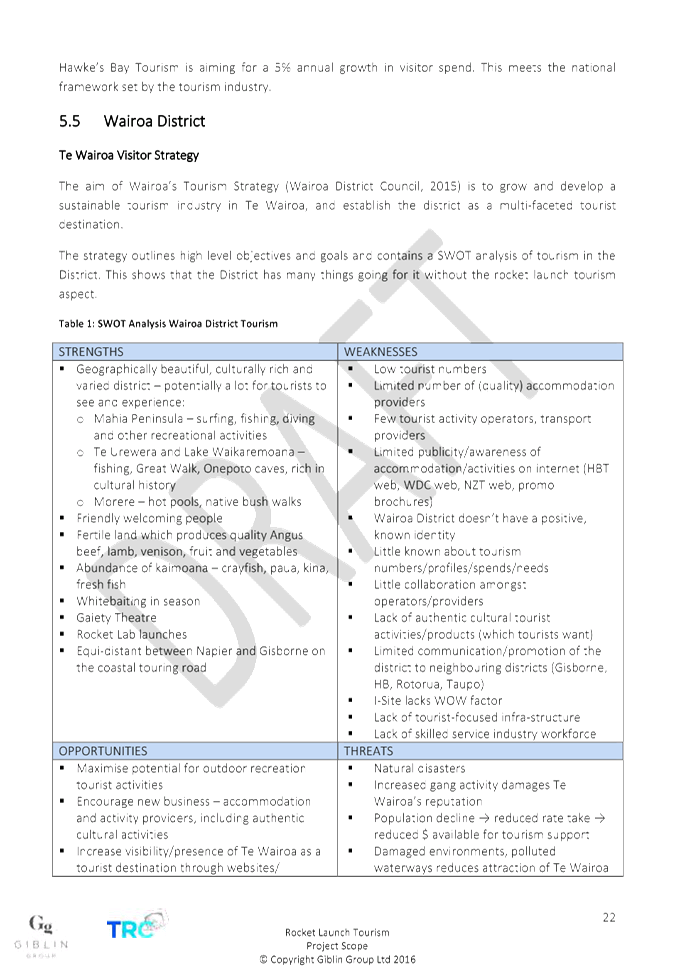
















|
Rocket
Tourism in Wairoa
|
Attachment 1
|
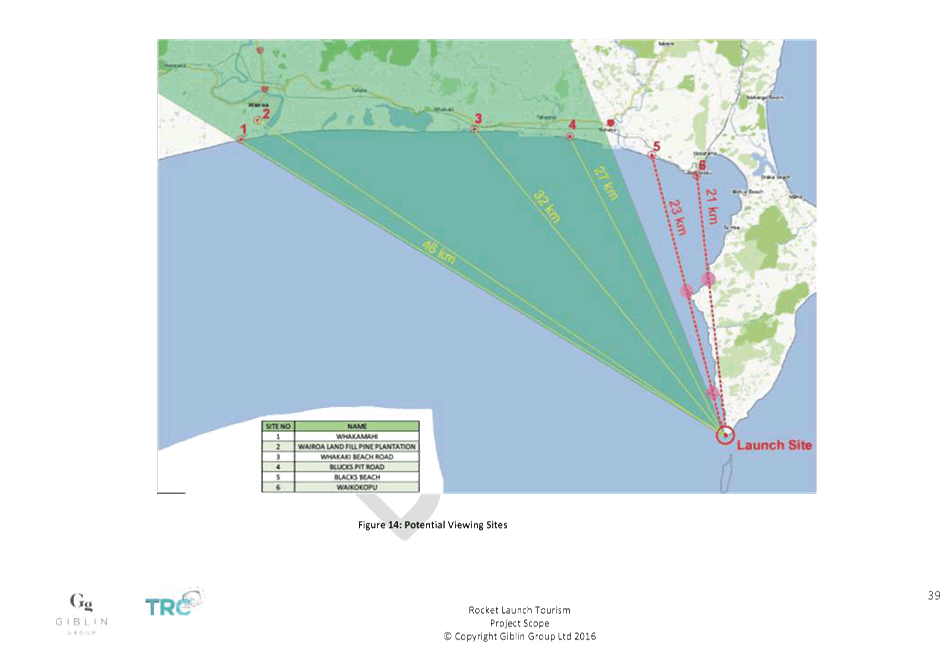


|
Rocket
Tourism in Wairoa
|
Attachment 1
|


|
Rocket
Tourism in Wairoa
|
Attachment 1
|




|
Rocket
Tourism in Wairoa
|
Attachment 1
|








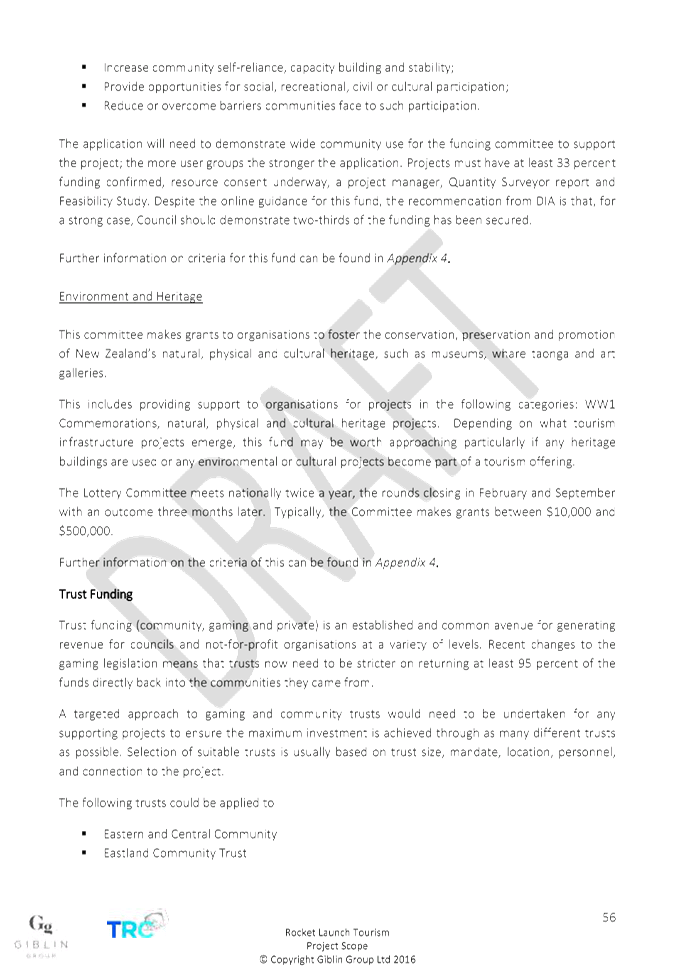

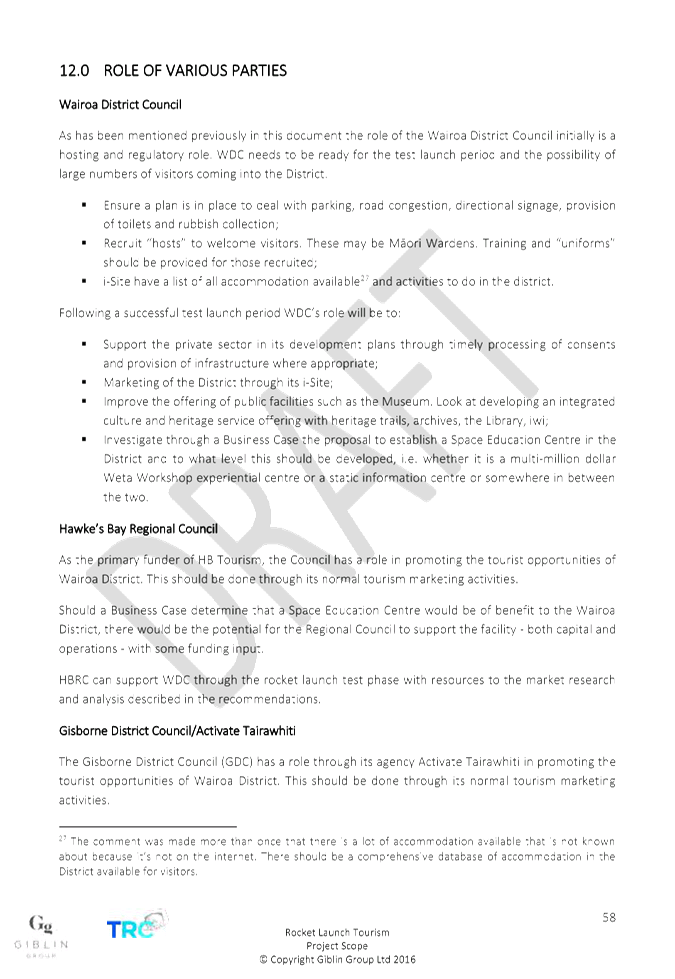

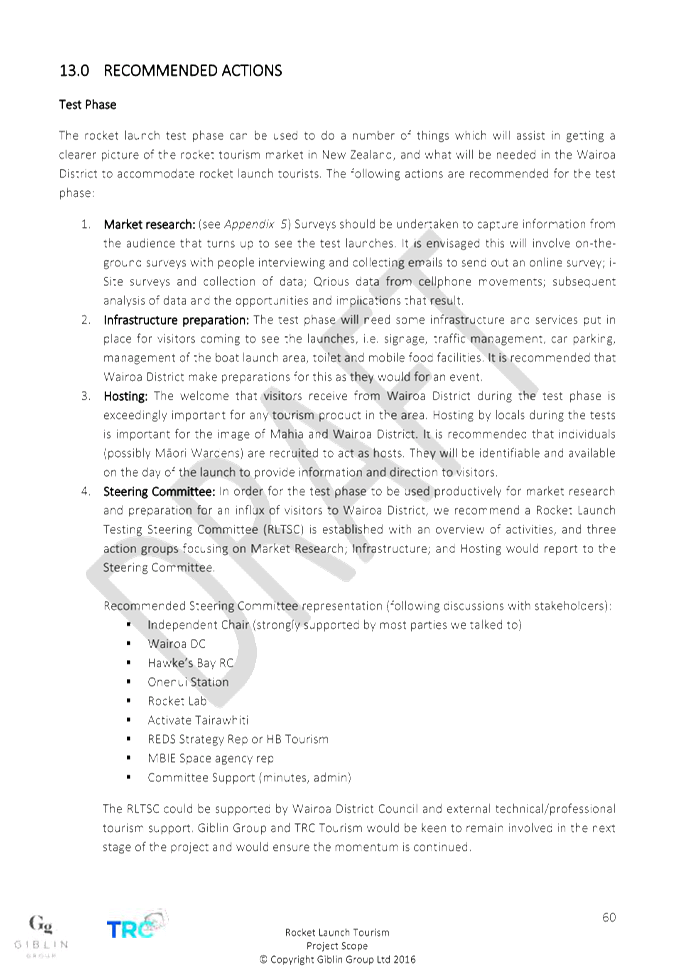




HAWKE’S BAY REGIONAL
COUNCIL
Corporate
and Strategic Committee
Wednesday 17 August 2016
Subject: Elected Representatives
Register of Interests Policy
Reason for Report
1. Having received
advice from Audit NZ about their expectations of Council’s “Elected
Members’ Register of Interests” as part of their annual audit, and
further to the questions raised by councillors as to what should or should not
be included in the register of interests, staff are providing this report to
clarify requirements for elected representatives about minimum expectations
when recording interests for HBRC.
2. It is proposed
that those expectations and requirements be reflected in an appropriate Policy,
which will be appended to the Code of Conduct for Elected Representatives.
Findings and Recommendations from Audit
New Zealand
3. In its
management letter to HBRC for its audit of the 2014-15 Annual Report Audit New
Zealand noted:
“The interest register
should be enhanced by documenting how any identified conflicts will be managed
or mitigated.
We noted that the interest
register does not include mitigating actions for potential conflict identified.
This creates a risk that conflicts identified are not addressed appropriately.
Due to the nature of the
public sector there will always be a level of inherent risk related to
conflicts of interest. In a small country such as ours it is quite common for
people to have multiple interests. However in the public sector, where high
standards of ethical conduct are expected, these interests need careful
management if they come into conflict.”
4. We note that
the majority of the interests registered by Councillors and key management
personnel (KMP) are shareholdings and directorships. Council’s
procurement policy mitigates significant contracts being awarded without proper
consideration of conflicts of interest.
5. Further, Audit
New Zealand noted:
“We
look at Councillor interests for both related parties and conflict of interest
so there is no threshold for those. Best practice would be to list everything
and then note why it is not something that would create a conflict or what
mitigation is in place if there is a potential conflict. Also Council should
have monitoring in place for Members Interests declared so $25k is not
inadvertently breached in relation to contracts with members providing services
to Council.
How Elected Members’ Interests are
Administered at Present
6. At its meeting
on 30 July 2014 HBRC adopted its amended Code of Conduct for Elected
Representatives (CoC). Section 3.8 of the CoC sets out the requirements for
members to make an annual declaration of interests.
7. The Register of
Interests is designed to achieve two things:
7.1. Provide
transparency in the governance of the Council, to increase public confidence
and to enhance the democratic process
7.2. Protect
elected members on the event of scrutiny and public criticism.
8. The Register of
Interests does not imply that a conflict of interest exists. It is a
public record of the interests held by the elected member in property, legal
entities and organisations within the region.
Local
Authorities (Members’ Interests) Act 1968
9. The Local
Authorities (Members Interests) Act (1968) (LAMIA) applies to the pecuniary
interests of members of local authorities. It controls the making of contracts
worth more than $25,000 in a financial year between members and their
authority; and it prohibits members from participating in matters before the
authority in which they have a pecuniary interest, other than an interest in
common with the public.
10. Section 6 of LAMIA sets
out where a pecuniary interest is deemed to exist and these are:
10.1. The member (or spouse or
partner) singly or between them own, directly or through a nominee, 10% of more
of the issued capital of the company, or of any other company controlling that
company
10.2. The member (or spouse or
partner) is a member of the company and either of them is the managing director
of the general manager of the company
10.3. The member (or spouse or
partner) is a member of a company controlling the company having a pecuniary
interest in the matter before the governing body of the local authority and
either the member or their spouse/partner is the managing director or the
general manager of that controlling company
10.4. The member (or spouse or
partner) is the managing director or general manager of the company having a
pecuniary interest in the matter before the governing body of the local
authority and either of them is a member of the company controlling that
company.
Clarification
of Matters Raised
11. Councillors have raised
questions regarding the content of the Register of Interests.
Benchmark
for inclusion in Register
12. One question has been
whether or not there is a benchmark below which an interest does not need to be
included in the Register.
13. As noted above the LAMIA
1968 specifies a “trigger” of 10% or more issued capital in a
company for assessing whether or not a conflict of interest exists. However, as
previously stated the Register of Interests is not a record of conflict of
interest – it is a matter of public record of interests that the elected
members has, and therefore there is no minimum threshold for inclusion.
Discretionary
Beneficiary
14. Audit New Zealand advises
that if an elected member is classed as a “discretionary
beneficiary” to a Trust there remains the ability for that member to
benefit from the Trust and therefore it should be included in the Register of
Interests.
Membership of Organisations
15. Membership of community
organisations is unlikely to give rise to a pecuniary interest in matters
involving those organisations because of their “not for profit”
nature. However in a situation where membership of an organisation entitles an
elected member to a share of the organisation’s assets if the
organisation is wound up a prospective pecuniary conflict of interest may
arise.
16. In respect of a
non-pecuniary conflict of interest, the risk of a Council decision being
challenged based on an elected member’s membership of an organisation is
likely to be very low if the elected member participates and:
16.1. They are a passive or
ordinary member of the club and the organisation is relatively large; or
16.2. The matter affects the
organisation only indirectly – such as a broad public policy issue in
which the organisation has chosen to take an interest.
17. In the interests of
transparency, however, it is recommended that the Register should reflect any
and all interests of the elected member on the Companies Register – even
if a member considers there is little or no risk of a conflict.
18. Audit New Zealand noted:
Companies
Check
Audit’s
expectation is that the client (HBRC) should have done their check against the
companies office register for both KMP and Councillors for both
directors/shareholdings and checked against their system for any transactions
as part of their year end review. If this check is documented the audit team
will recheck.”
Mitigation of
Pecuniary Conflicts of Interest
19. The management letter from
Audit New Zealand states:
We noted that the interest
register does not include mitigating actions for potential conflict identified.
This creates a risk that conflicts identified are not addressed appropriately.
20. For most of the inclusions
in the Register Council’s procurement policy mitigates significant
contracts being awarded without proper consideration of conflicts of interest.
21. Other mitigation measures
could include, but are not limited to:
21.1. taking no action
(transparency through noting the interest in the Register is sufficient)
21.2. seeking a formal
exemption to allow participation (if such a legal power applies)
21.3. withdrawing from
discussing or voting on a particular item of business at a meeting;
21.4. relinquishing the
private interest
21.5. resignation from one or
other position or entity.
22. It is proposed that the
Council’s Register of Interests includes provision for members to
identify mitigation actions.
Conclusion
23. The Register of Interests
for Elected Members is a tool for helping Council to conduct it business in an
open, transparent and democratically accountable manner.
24. The Register of Interests
is intended to be a publicly available document that identifies all the
interests an elected member has within Hawke’s Bay.
25. The addressing of a
conflict of interest, either perceived or real, and either pecuniary or
non-pecuniary, sits within several pieces of legislation. At the suggestion of
Audit New Zealand the Register of Interests should identify courses of action
that a member may take to avoid such conflicts.
26. The Draft Policy attached
for the Committees consideration is based upon the current content within the
Code of Conduct and it is proposed that the policy be appended to the Code of
Conduct upon its adoption.
Decision Making
Process
27. Council
is required to make every decision in accordance with the requirements of the
Local Government Act 2002 (the Act). Staff have assessed the requirements
in relation to this item and have concluded:
27.1. The decision
does not significantly alter the service provision or affect a strategic asset.
27.2. The use of
the special consultative procedure is not prescribed by legislation.
27.3. The decision
does not fall within the definition of Council’s policy on significance.
27.4. The persons affected directly
by this decision are elected representatives on the Hawke’s Bay Regional
Council and ratepayers, and indirectly the ratepayers of the region.
27.5. Options that
have been considered include not preparing a policy but continuing to
rely on content of Code for Conduct.
27.6. The decision
is not inconsistent with an existing policy or plan.
27.7. Given
the nature and significance of the issue to be considered and decided, and also
the persons likely to be affected by, or have an interest in the decisions
made, Council can exercise its discretion and make a decision without
consulting directly with the community or others having an interest in
the decision.
|
Recommendations
1. The Corporate and Strategic Committee receives and notes the
“Elected Representatives Register of Interests Policy” report.
2. The Corporate and Strategic Committee recommends that Council:
2.1. Agrees that the decisions to be made are not significant under the
criteria contained in Council’s adopted Significance and Engagement
Policy, and that Council can exercise its discretion under Sections 79(1)(a)
and 82(3) of the Local Government Act 2002 and make decisions on this issue
without conferring directly with the community and persons likely to be
affected by or to have an interest in the decision.
2.2. Adopts the Policy on Register of Interests for Elected Members,
including any amendments agreed at the Committee meeting.
|
Authored and Approved
by:
|
Liz Lambert
Chief
Executive
|
|
Attachment/s
|
1
|
Draft
Register of Interests Policy for Elected Members
|
|
|
|
Draft
Register of Interests Policy for Elected Members
|
Attachment 1
|

HAWKE’S BAY REGIONAL COUNCIL
Corporate
and Strategic Committee
Wednesday 17 August 2016
SUBJECT: Code of Conduct for Elected Representatives Review
Reason for Report
1. Under Schedule
7 Part 15 of the Local Government Act 2002, councils are required to adopt a
Code of Conduct for members of the Council at the beginning of each triennium.
Clause 4.3 of Council’s Code of Conduct requires Council to formally
review the Code prior to the end of each three year term. Any suggestions for
improvement and recommended amendments will be noted and referred to the new
Council.
Background
2. Schedule 7 Part 15 of the Local Government Act 2002 states:
‘15. Code of
conduct—
(1) A
local authority must adopt a code of conduct for members of the local authority
as soon as practicable after the commencement of this Act.
(2) The
code of conduct must set out—
(a) understandings
and expectations adopted by the local authority about the manner in which
members may conduct themselves while acting in their capacity as members,
including—
(i) behaviour
toward one another, staff, and the public; and
(ii) disclosure
of information, including (but not limited to) the provision of any document,
to elected members that—
(A) is
received by, or is in the possession of, an elected member in his or her
capacity as an elected member; and
(B) relates
to the ability of the local authority to give effect to any provision of this
Act; and
(b) a general
explanation of—
(i) the
Local Government Official Information and Meetings Act 1987; and
(ii) any
other enactment or rule of law applicable to members.
(3) A
local authority may amend or replace its code of conduct, but may not revoke it
without replacement.
(4) A
member of a local authority must comply with the code of conduct of that local
authority.
(5) A
local authority must, when adopting a code of conduct, consider whether it must
require a member or newly elected member to declare whether or not the member
or newly elected member is an undischarged bankrupt.
(6) After
the adoption of the first code of conduct, an amendment of the code of conduct
or the adoption of a new code of conduct requires, in every case, a vote in
support of the amendment of not less than 75% of the members present.
(7) To
avoid doubt, a breach of the code of conduct does not constitute an offence
under this Act.’
Discussion
3. The current Code of Conduct was adopted by Council on 30 July 2014,
and a copy is attached.
4. In the Chairman’s view the Code of Conduct is at present of
little value because when it is required to be used there are no sanctions to
back up any possible action. The Chairman requests that the incoming Council
closely considers the effectiveness of the Code as currently adopted.
Decision Making
Process
5. Council is required to make every decision in accordance with the
requirements of the Local Government Act 2002 (the Act). Staff have
assessed the requirements contained in the Act in relation to this item and
have concluded:
5.1. The decision
does not significantly alter the service provision or affect a strategic asset.
5.2. The use of the
special consultative procedure is not prescribed by legislation.
5.3. The decision
does not fall within the definition of Council’s policy on significance.
5.4. The persons
affected by this decision are the elected representatives.
5.5. The decision
is not inconsistent with an existing policy or plan.
5.6. Given the
nature and significance of the issue to be considered and decided, and also the
persons likely to be affected by, or have an interest in the decisions made,
Council can exercise its discretion and make a decision without consulting
directly with the community or others having an interest in the decision.
|
Recommendations
1. That the Corporate and Strategic Committee receives and notes the
“Code of Conduct for Elected Representatives Review” report.
2. The Corporate and Strategic Committee recommends that Council:
2.1. Agrees that the decisions to be made are not significant under the
criteria contained in Council’s adopted Significance and Engagement
Policy, and that Council can exercise its discretion and make decisions on
this issue without conferring directly with the community and persons likely
to be affected by or to have an interest in the decision.
2.2. Recommends the adoption of the attached Code of Conduct by the
incoming Council for the 2016-19 triennium, subject to any changes made to
enhance the effectiveness of the Code through the development of effective
sanctions for breaches.
|
Authored and Approved
by:
|
Liz Lambert
Chief Executive
|
|
Attachment/s
|
1
|
Code of
Conduct for Recommendation to Incoming 2016-19 Regional Council
|
|
|
|
Code
of Conduct for Recommendation to Incoming 2016-19 Regional Council
|
Attachment 1
|









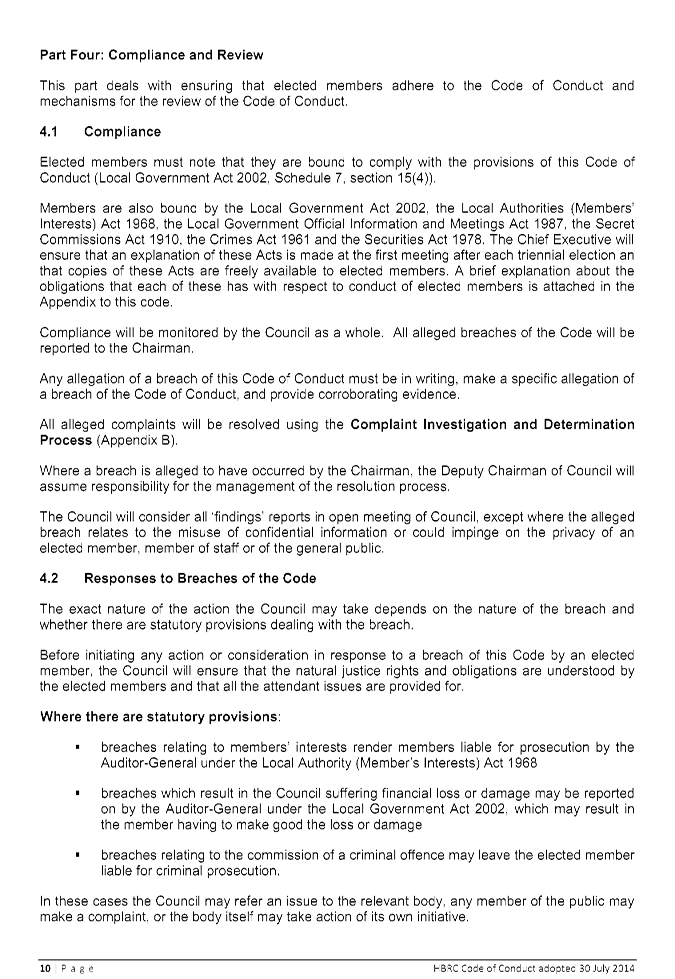







HAWKE’S BAY REGIONAL COUNCIL
Corporate
and Strategic Committee
Wednesday 17 August 2016
Subject: Proposed Governance
Structure Recommendation to the Incoming Council for the 2016-19 Triennium
Reason for Report
1. At the end of a triennium, Council traditionally recommends a
Committee structure to the incoming Council. This structure needs to enable
Council to effectively discharge its responsibilities over the next three
years. This paper proposes a structure and associated delegations for Council
to consider for recommendation.
Background
2. Appropriate governance structures are vital to enable Council to
function effectively as an organisation. As part of the ongoing process of
working to improve the overall effectiveness and efficiency of Council there
has been discussion around appropriate Committee arrangements for the next
triennium.
3. Council’s current structure has been operating since 2015,
with the establishment of the Finance, Audit and Risk Sub-committee. Prior to
that there had been no significant changes to the Committee structure since
2012.
4. The current structure operates as follows.

5. Council is
required by statute to have a Regional Transport Committee and a Regional
Planning Committee. The Civil Defence Emergency Joint Committee is required
under section 12 (1) of the Civil Defence Emergency Management Act (2002).
6. The Environment
and Services Committee and the Corporate and Strategic Committee consider and
make recommendations to Council on wide-ranging matters related to the
undertaking of Council’s business.
7. Other
committees cover specific issues, such as selection of tenders (Tenders
Committee) in excess of staff financial delegations, and resource consent
hearings. These committees both meet when required.
8. The Māori
Committee is made up of representatives of four taiwhenua within Hawke’s
Bay, as well as three councillors, and makes recommendations to the Council on
matters of relevance affecting the tangata whenua of the region.
Comments on Specific Committees
Environment
and Services Committee
9. This Standing
Committee covers many of the operational activities of Council, especially
those of the Asset Management and Resource Management groups. Over the current
triennium 14 Environment and Services Committee meetings have been held and no
meeting has extended beyond six hours duration. This suggests that the meeting
frequency and the meeting agendas are pitched about right. It is proposed that
the Environment and Services Committee be retained with its current Terms of
Reference and that 4-5 meetings are scheduled in any calendar year.
Corporate and Strategic Committee
10. This Standing Committee is
responsible for considering and recommending to Council strategic planning
initiatives including development of the Council’s Strategic Plan and
other strategic initiatives with external stakeholders. It also deals with a
number of operational issues outside of the Asset Management and Resource
Management Group remits.
11. Over the current triennium
the Corporate and Strategic Committee has met 15 times, of which two meetings
were for specific single items (Napier-Gisborne Rail, and the Deloitte Peer
Review).
12. With the establishment of
the Finance, Audit and Risk Sub-committee in 2015 some of the Corporate and Strategic
Committee workload has been diverted, and generally speaking, the Corporate and
Strategic Committee agendas have dealt with fewer items and been of shorter
duration.
13. The Corporate and
Strategic Committee remains an important vehicle for dealing with a range of
Council’s business. However it is recommended that the Chair of this
committee also be appointed as chair of Finance, Audit and Risk to prove a
comparable workload to the Environment and Services Committee Chair role.
Finance,
Audit and Risk Sub-committee
14. The Finance Audit and Risk
Sub-committee is responsible for examining the robustness of Council’s
risk management systems, of appropriate controls to safeguard the
Council’s financial and non-financial assets, and the independence and
adequacy of internal and external audit functions.
15. It meets four times each
calendar year. At present the Sub-committee reports to Council via the
Corporate and Strategic Committee. This reporting line was set up as the
sub-committee was developed when there was a level of uncertainty about how it
would operate in relation to the C & S Committee.
16. It is now recommended that
the sub-committee be re-named as a committee, retains the membership of four
councillors and one independent member, and reports directly to Council, and
that the Terms of Reference be amended accordingly. This has the advantage of
allowing scheduling of this committee to alternate with the C & S Committee
rather than being dependent on it.
Emergence of
the Hawke’s Bay Regional Planning Committee Act 2015
17. In August 2015 the
Hawke’s Bay Regional Planning Committee Act came into effect.
18. The purpose of the Act is
to improve Tāngata Whenua involvement in the development and review of
documents prepared in accordance with the Resource Management Act 1991 for the
Hawke’s Bay region.
19. That Act also establishes
the Hawke’s Bay Regional Planning Committee (RPC) as a joint committee of
the Hawke’s Bay Regional Council.
20. Given the workload
expected to be undertaken by the Regional Planning Committee staff will be
giving serious consideration to increased meeting frequency for this committee
as part of the drafting of the Meeting Schedule for 2017.
21. Enactment of the RPC Act
prompts at least two matters which both require further consideration by the
incoming Council:
21.1. the future respective
roles of the RPC and the HBRC Maori Committee; and
21.2. appointment of an
additional member to retain equal numbers with Tāngata Whenua RPC
membership.
Appointment
of an Additional Council member to RPC
22. The RPC Act provides for
an equal number of Tāngata Whenua members and Council members. With
the trustees of Tūhoe Te Uru Taumatua likely to soon appoint their member,
there will be ten Tāngata Whenua RPC members. Section 11(1)(j) of the RPC
Act anticipates ten council members appointed by the Council. Given there are
only nine councillors, the tenth position will require an appointment in
accordance with clause 31(3) of
Schedule 7 of the Local Government Act 2002. That clause requires Council to be
satisfied that the person appointed “has the skills, attributes, or
knowledge that will assist the work of the committee.”
23. There are a number of
options how the Council might approach the task of appointing a tenth member to
the RPC. Staff intend presenting a range of options for the incoming
Council to consider in November.
Maori Committee
24. The Māori Committee
is made up of representatives of Ngati Kahungunu Iwi Incorporated’s four
taiwhenua within Hawke’s Bay, as well as three councillors, and makes
recommendations to the Council on matters of relevance affecting the tangata
whenua of the region. It meets up to five times per year.
Discussions within Tāngata
Whenua about Role of Maori Committee and Regional Planning Committee
25. Within the RPC Tāngata
Whenua membership, discussions occurred regarding the role and purpose of the Māori
Committee. To further explore this, a joint meeting was called by both the
Chairs of the respective committees, Mike Mohi (Māori Committee) and Toro
Waaka (Co-Chair RPC).
26. Following the meeting on
the 4 July in Napier, key items emerged that looked to the functionality of
both committees and the needs of Māori externally and servicing the
Council and its staff.
27. It was recommended that a
further discussion occur with Council staff to draft an options paper going
forward.
28. Staff believe there is a
need to explore the ongoing relevance of the Māori Committee particularly
as it relates to engagement with Tāngata Whenua. The key issues that
staff believe relate to this discussion include the following:
28.1. HBRC needs to fulfil
statutory responsibilities to engage in planning, resource consents and with
its operational activities
28.2. The Pātaka tool (an
online resource of Tāngata Whenua information in Hawke's Bay) provides the
connection with key contacts and staff within their daily work programmes have
established strong relationships with Tāngata Whenua which includes local
marae and whanau groupings.
28.3. With the majority of the
Treaty settlement groups having now settled with the Crown HBRC has a larger
number, and depth, of relationships with tāngata whenua that needs
proactive management
28.4. HBRC needs to develop
greater cultural competency and staff awareness of obligations and
expectations. This was the background for the Māori Committee’s LTP
request in 2015 for an Executive-level appointment to operate in this space.
28.5. Recent Māori
Committee hui in Wairoa and Tamatea have highlighted the benefits of reaching
out to the community. Greater structure and regularity to this would be
desirable
28.6. For the effective
functioning of the Regional Planning Committee HBRC needs to look at greater
support for the RPC and at the involvement of RPC in Council matters that
affect tāngata whenua, including engagements on significant matters.
Next Steps
29. In relation to the future
role of the Māori Committee a report will be submitted for consideration
at the 28 September Council meeting. This report will be guided by the
discussion held at the August Corporate and Strategic Committee meeting, and
particularly the response of committee members to the matters raised in
paragraph 27, and any other matters raised at the meeting.
Decision Making
Process
30. Council
is required to make every decision in accordance with the requirements of the
Local Government Act 2002 (the Act). Staff have assessed the requirements
in relation to this item and have concluded:
30.1. The decision
does not significantly alter the service provision or affect a strategic asset.
30.2. The use of
the special consultative procedure is not prescribed by legislation.
30.3. The decision
does not fall within the definition of Council’s policy on significance.
30.4. The persons affected by this
decision are incoming councillors and those members of staff and the public
participating in and contributing to Council and Committee meetings.
30.5. The decision
is not inconsistent with an existing policy or plan.
30.6. Given
the nature and significance of the issue to be considered and decided, and also
the persons likely to be affected by, or have an interest in the decisions
made, Council can exercise its discretion and make a decision without
consulting directly with the community or others having an interest in
the decision.
|
Recommendations
1. That the Corporate and Strategic Committee receives and notes the
“Proposed Governance Structure Recommendation to the Incoming Council
for the 2016-19 Triennium” report.
2. The Corporate and Strategic Committee recommends that Council:
2.1. Agrees that the decisions to be made are not significant under the
criteria contained in Council’s adopted Significance and Engagement
Policy, and that Council can exercise its discretion under Sections 79(1)(a)
and 82(3) of the Local Government Act 2002 and make decisions on this issue
without conferring directly with the community and persons likely to be
affected by or to have an interest in the decision.
2.2. Notes to the incoming Council that the Regional Planning
Committee, the Regional Transport Committee and the Civil Defence Emergency
Joint Committee are all required by statute and their establishment is not
subject to a decision of Council.
2.3. Requests staff provide a report with recommendations on the future
role of the Māori
Committee for consideration at the 28 September 2016 Council meeting.
2.4. Recommends to the incoming Council that the current Committee
Structure be retained with the following exceptions:
2.4.1. The Finance, Audit and Risk sub-committee be established as a
committee reporting directly to Council
2.4.2. The Corporate and Strategic Committee and the Finance, Audit and
Risk Committee be chaired by the same elected representative
2.4.3. Final recommendations on the Māori Committee will be made at the 28 September Council
meeting..
2.5. Agrees that the Council’s appointment of an additional
member to the Regional Planning Committee will be a matter for the incoming
Council to decide at its 9 November 2016 meeting, as part of its process
of adopting the 2016-19 Governance structure.
|
Authored by:
|
Leeanne
Hooper
Governance & Corporate Administration
Manager
|
Gavin Ide
Manager, Strategy and Policy
|
|
Joyce-Anne
Raihania
Senior Planner
Maori Policy Advisor
|
|
Approved by:
|
James Palmer
Group Manager
Strategic Development
|
Liz Lambert
Chief Executive
|
Attachment/s
There are no
attachments for this report.
HAWKE’S BAY REGIONAL COUNCIL
Corporate
and Strategic Committee
Wednesday 17 August 2016
Subject: Napier Port Presentation
of 2015-16 Year End Results
Reason for Report
1. Garth Cowie (CEO) and Alasdair MacLeod (Chairman) will present
Napier Port’s 2015-16 Year End Results, highlights from the year and key development initiatives being
progressed.
Decision Making
Process
2. Council is
required to make every decision in accordance with Part 6 Sub-Part 1, of the
Local Government Act 2002 (the Act). Staff have assessed the requirements
in relation to this item and have concluded that, as this report is for
information only and no decision is to be made, the decision making provisions
of the Local Government Act 2002 do not apply.
|
Recommendation
1. That the Corporate and Strategic Committee
receives and notes the “Napier Port
Presentation of 2015-16 Year End Results”
report.
|
|
Liz Lambert
Chief Executive
|
|
Attachment/s
There are no
attachments for this report.
HAWKE’S BAY REGIONAL
COUNCIL
Corporate
and Strategic Committee
Wednesday 17 August 2016
Subject: August 2016 Public
Transport Update
Reason
for Report
1. This agenda item provides the Committee with an update on
Council’s public transport operations.
General
Information
2. Preparations are well underway for the
implementation of bus improvements in conjunction with the start of the new bus
contract, which was on 1 August 2016. As outlined in paragraph 12, service and
timetable alterations are due to be introduced from Monday 26 September.
3. Patronage in regional centres around the country
continues to decline, with decreases consistent with those seen in
Hawke’s Bay. Most regional councils consider that lower petrol prices are
the major reason for this.
Bus Passenger Trips
4. Diagram 1 shows monthly bus passenger trips during 2012-13, 2013-14,
2014-15 and 2015-16 for the year to 30 June.
Diagram 1 – Monthly Passenger Trips
– 2012-13, 2013-14, 2014-15, 2015-16
|
|
Jul
|
Aug
|
Sep
|
Oct
|
Nov
|
Dec
|
Jan
|
Feb
|
Mar
|
Apr
|
May
|
Jun
|
|
2012-13
|
59,275
|
74,493
|
61,847
|
60,530
|
64,913
|
46,029
|
47,577
|
67,463
|
76,119
|
63,430
|
76,924
|
62,792
|
|
2013-14
|
64,869
|
78,729
|
69,564
|
63,807
|
67,784
|
50,219
|
48,391
|
70,647
|
82,265
|
63,285
|
74,988
|
65,297
|
|
2014-15
|
64,349
|
73,204
|
68,927
|
62,049
|
64,088
|
48,558
|
43,049
|
63,065
|
74,992
|
53,197
|
67,101
|
62,113
|
|
2015-16
|
59,690
|
67,216
|
62,415
|
56,548
|
58,647
|
44,812
|
35,631
|
62,897
|
67,018
|
53,679
|
66,159
|
59,537
|
5. Diagram 2 shows
the annual passenger numbers for the same years with the year-on-year
percentage change.
Diagram 2 – Annual Passenger Numbers
|
Year
|
Total Passengers
|
% change
|
|
2012-13
|
761,392
|
|
|
2013-14
|
799,845
|
5.1
|
|
2014-15
|
744,692
|
-6.9
|
|
2015-16
|
694,357
|
-6.8
|
6. The average monthly and daily patronage for
the year to 30 June for 2012-13, 2013-14, 2014-15 and 2015-16 is shown in Diagram 3.
Diagram 3 – Monthly and Daily Average Passenger Trips for the
year to 30 June.
|
|
Monthly
|
Daily
|
|
Year
|
Average passengers
|
Average passengers
|
|
2012-13
|
63,449
|
2,884
|
|
2013-14
|
66,654
|
3,030
|
|
2014-15
|
62,058
|
2,821
|
|
2015-16
|
57,863
|
2,630
|
7. Analysis of patronage by route for 2015-16 shows that about 52% of
passengers are carried on the Route 12 (Napier to Hastings and return). A
further 16% is carried on the next most popular service – the Route 20
between Hastings and Flaxmere.
8. Diagram 4 shows the breakdown of patronage by user groups.
Diagram 4 – GoBay bus patronage by
user group (2015-16)
|
User Group
|
% of Passengers
|
|
Adults
|
17.5
|
|
Children
|
25.1
|
|
Community Service Card
|
16.8
|
|
SuperGold
|
18.5
|
|
Tertiary Students
|
12.2
|
|
Other ( DHB travel, promotions etc)
|
9.9
|
Bus Service Costs
9. The following diagram shows the annual net cost (after fares and
excluding GST) of operating the goBay bus service for the years to 30 June in 2012-13,
2013-14, 2014-15 and 2015-16.
10. The diagram also shows the average cost per
passenger and cost per passenger-kilometre. Passenger–kilometres is a
measure widely used for reporting public transport results, as it reflects the
distance that passengers have travelled, rather than just a head count of
boardings.
Diagram 5 – Annual net cost, cost per passenger and cost per
passenger-kilometre (excl GST)
|
Year
|
Annual net cost
|
Annual net cost per passenger
|
Annual net cost per passenger km
|
|
2012-13
|
$ 2,702,740.93
|
$ 3.55
|
$ 0.33
|
|
2013-14
|
$ 2,464,876.09
|
$ 3.08
|
$ 0.30
|
|
2014-15
|
$ 2,243,606.69
|
$ 3.01
|
$ 0.30
|
|
2015-16
|
$ 2,233,500.67
|
$ 3.22
|
$ 0.31
|
(53% of this cost is met by the New Zealand Transport
Agency).
Fare Recovery
11. Fare recovery is the portion of the total cost of the service that
is covered by fares (including Supergold payments from central government).
Diagram 5 shows fare recovery in 2012-13, 2013-14,
2014-15 and 2015-16.
Diagram 5 – Fare Recovery – 2012-13, 2013-14, 2014-15 and
2015-16
|
2012-13
|
34.26%
|
|
2013-14
|
38.24%
|
|
2014-15
|
38.69%
|
|
2015-16
|
37.77%
|
Service Changes
12. Significant
service changes are planned to commence on Monday 26 September 2016. These are:
|
Route 10
|
New commuter
express service linking Napier and Hastings via the HB Expressway.
|
Specifically
timed to meet the needs of shift workers at the HB Hospital.
|
|
Route 15
|
An extension
of the service from Westshore out as far as Bay View.
|
The trial
extension will run 4 times a day, 6 days a week.
|
|
Route 17
Hastings Urban
|
Minor
re-routing at Karamu High School / Windsor Park as well as an increase in
frequency from 3 to 7 services per day.
|
Timed to
meet the needs of students at the High school and residents at the retirement
village.
|
|
Route 20
Flaxmere
|
An
additional early service and Sunday services on the Hastings – Flaxmere
run.
|
Offering
increased flexibility for passengers from Flaxmere.
|
|
Route 21
Havelock North
|
Route
extension to Arataki Rd; re-routing at Lipscombe Cres, additional early
services and a Sunday service to Havelock North.
|
These
services are being developed with groups such as shift workers and residents
of the retirement village in mind.
|
|
Fares
|
There are to
be no fare increases, but fare reductions apply for adults who make the
2-zone journey (Napier-Hastings) and for a 1-zone fare and concessions on the
Route 10 and 11 express services.
|
Bus Stops
13. Hastings
District Council has decided to relocate the main bus stop at Eastbourne St to
a position one block further south east, in front of the Library.
HBRC staff are working with staff from HDC to ensure that the new stops are
suitable for their purpose and location; that services are not affected and
that disruption during the transfer is minimised.
14. In order
to deliver the service changes described above, new bus stops have been
installed at Bay View, Meeanee Rd, Karamu High School, Havelock North and
central Hastings. This work is in co-operation with NCC and HDC and follows
consultation with affected residents and service users.
SuperGold Card Scheme
Update
15. As
outlined at earlier meetings, changes to the way SuperGold card scheme funding
is to be allocated will have a slight effect on the amount received by
Hawke’s Bay Regional Council. A transitional
approach is in place for 2016-17, based on SuperGold numbers carried in
2015-16.We have received notification of our target allocation for 2016-17,
which is $247,260 (ex GST). This is approximately $2,000 more than was received
in 2015-16 but planned service improvements could increase SuperGold patronage
and therefore this allocation could be exceeded. NZTA will closely
monitor the forecast spend for each region in order to work out how to allocate
limited funds into the future.
Total
Mobility
16. The
following tables compare the number of Total Mobility trips made during
2012-13, 2013-14, 2014-15 and 2015-16 to 30 April, and the corresponding costs
(excl GST).
17. The
number of TM trips for the year is only slightly higher than in 2014-15; it
appears that growth in use is slowing. Overall expenditure was less than in
2014-15. The number of Total Mobility users registered with the Council at 30
June was 3,290, down from 3,460 the previous year.
Diagram
6 – Total Mobility Trips – 2012-13, 2013-14, 2014-15, 2015-16
|
Year
|
Jul
|
Aug
|
Sep
|
Oct
|
Nov
|
Dec
|
Jan
|
Feb
|
Mar
|
Apr
|
May
|
June
|
Total
|
|
2012-13
|
6,753
|
6,839
|
6,471
|
7,256
|
6,925
|
6,447
|
6,022
|
6,320
|
6,614
|
6,850
|
7,106
|
6,382
|
79,985
|
|
2013-14
|
7,401
|
6,804
|
6,611
|
7,658
|
7,365
|
7,185
|
6,546
|
7,032
|
7,605
|
7,745
|
7,707
|
7,188
|
86,847
|
|
2014-15
|
8,320
|
7,950
|
7,677
|
8,267
|
7,701
|
7,948
|
6,354
|
6,901
|
8,245
|
7,328
|
7,737
|
7,852
|
92,280
|
|
2015-16
|
7,949
|
7,219
|
8,186
|
7,708
|
7,876
|
7,974
|
6,464
|
7,325
|
8,064
|
7,806
|
8,190
|
8,044
|
92,805
|
Diagram 7 – Total Mobility Cost ($
excl GST) – 2012-13, 2013-14, 2014-15, 2015-16
|
Year
|
Jul
|
Aug
|
Sep
|
Oct
|
Nov
|
Dec
|
Jan
|
Feb
|
Mar
|
Apr
|
May
|
June
|
Total
|
|
2012-13
|
44,451
|
44,877
|
43,241
|
46,217
|
45,383
|
39,881
|
37,347
|
40,682
|
44,382
|
43,927
|
47,612
|
43,394
|
521,394
|
|
2013-14
|
49,274
|
46,153
|
43,965
|
50,189
|
47,744
|
46,968
|
39,581
|
46,567
|
52,047
|
50,715
|
51,078
|
49,349
|
573,630
|
|
2014-15
|
55,780
|
53,489
|
51,223
|
54,492
|
53,591
|
49,973
|
38,990
|
45,943
|
52,581
|
46,747
|
50,971
|
51,422
|
605,202
|
|
2015-16
|
50,877
|
46,255
|
52,340
|
48,692
|
51,546
|
50,992
|
40,488
|
46,215
|
52,418
|
50,688
|
53,458
|
51,945
|
595,914
|
(60% of this
cost is met by the New Zealand Transport Agency)
Decision Making
Process
18. Council is required to
make every decision in accordance with Part 6 Sub-Part 1, of the Local
Government Act 2002 (the Act). Staff have assessed the requirements in
relation to this item and have concluded that, as this report is for
information only and no decision is to be made, the decision making provisions
of the Local Government Act 2002 do not apply.
|
Recommendation
1. That the Corporate and Strategic Committee
receives and notes the “August 2016 Public Transport Update”
report.
|
Authored by:
|
Anne Redgrave
Transport Manager
|
|
Approved by:
|
Liz Lambert
Chief Executive
|
|
Attachment/s
There are no
attachments for this report.
HAWKE’S BAY REGIONAL
COUNCIL
Corporate
and Strategic Committee
Wednesday 17 August 2016
Subject: Human
Resources 2015-16 Annual Report
Reason for Report
1. This agenda item is to provide Council with an overview of the key
human resource metrics recorded for the year 1 July 2015 to 1 July 2016.
A copy of the HR Highlights document is appended as Attachment 1.
2. This report also provides the Committee with an update of key health
and safety information for the same period.
Key Metrics
Staff Numbers (Previous year in brackets)
3. As at 1 July 2016 187.3 FTE (180.8 FTE).
3.1. Dalton Street (including Waipukurau and Wairoa): 159.3 FTE (152.8)
3.2. Works Group (Taradale and Waipukurau): 28 FTE (28)
4. Turnover for the year ending 30 June 2016 was 5 % (2015 – 6%).
10 staff left during the year. 4 staff members were internally promoted to a
new position during the year.
5. The Lawson Williams – HRINZ New Zealand Staff Turnover Survey
indicated an average turnover of 18.4 % for contributing organisations in 2015.
For contributing local government organisations the average turnover was 13.2
%.
6. Extensive exit interviews are held with all departing staff to get
feedback on a range of issues related to their work while with Council and the
reasons for leaving. For this past year that feedback has not indicated any
issues of concern related to the reason for leaving.
Staff Leave Usage
7. The average number of sick days used was 6.8, marginally up on last
year (6 days). There was an increase in the total sick days used, 1035 days
compared to 931 in 2015. The number of staff taking more than the annual
allocation (10 days) increased to 22% from 15% last year. This is only possible
where they have accumulated sick leave to use.
8. While there has been an increase in staff numbers that accounts for
some of the increased average use of sick leave, it is interesting to note that
the average has increased from around 4 days in 2000-2005 period, increasing to
4.5 days in the 2005-2008 period, increasing to an average of 6 days in the
last few years.
9. Annual leave usage remained constant at an average of 19.3 days per
staff.
Average
Age/Tenure/Workforce Composition
10. The
average age of Dalton street staff was 46 and the average tenure 9 years.
11. For Works
Group staff the average age was 50 with an average tenure of 11.5 years.
12. This year
the report also proves details of the gender and Maori composition of the
workforce. While the overall gender numbers are comparable the number of female
staff in manager/team leader roles is significantly below their male
counterparts.
13. While
there has been an increase in the number of Maori staff very few are in senior
or supervisory roles.
Health and Safety
14. Council
retained tertiary level in ACC’s Workplace Safety Management Practices
programme. This is effective for two years to June 2018.
15. While
this achievement does mean we receive a significant saving on Council’s
ACC levies, more importantly it provides a ‘level of confidence’
that our policies and procedures are appropriate for promoting a safe workplace
with safe work practices.
16. It is
understandable that workplaces focus strongly on safety but it is also
important to also consider the health aspects of the workplace. Council has a
number of initiatives in this area, e.g. assistance with regular medical and
melanoma checks, flu injections, provision of information on healthy eating and
exercise, regular workplace support and a variety of health promotions and
activities to promote a balanced and healthy lifestyle.
17. There
were no ‘serious harm’ (‘notifiable event’ in the new
Health and Safety at Work Act) during the year that required notification to
WorkSafe.
18. Dalton
Street staff had 25 work related ‘incidents’ reported through the
year. 10 were ‘near miss’ incidents (no injury), the rest were
slips, falls, cuts, strains resulting in 51 days off work. However, two work
related accidents accounted for 41 days of that total, the rest were either no
time off or only a day or two off.
19. Works
Group achieved another excellent year in terms of their safety record. There
were 8 reported work related accidents with only one requiring any time off (4
days- strained ankle).
20. Use of
the workplace support service has provided council with an independent insight
into the ‘general mood’ of the workplace over the past year. The
overall feedback is that of a positive workplace but staff have found the
continued negative press coverage, particularly around the RWSS, a distraction
which has overshadowed a lot of the good work carried out by Council.
Staff Training and
Qualifications
21. The
training budget was 2.4% of the salary budget which is an increase on last
year’s 2%.
22. The main
focus for training has remained on leadership development and we have continued
to identify appropriate staff to undertake the training programme developed for
this purpose. Those that attend have indicated that the content and relevance
has had a significant positive impact on their work activities.
23. With the
change in health and safety legislation a concerted effort has been made to
provide relevant information about the changes to relevant staff to ensure the
implications are well understood.
24. The
overall staff qualifications can be seen in the attached HR Highlights. Over
100 staff have a degree or above qualification, including 8 with PhDs.
25. This also
reinforces the need to source and retain skilled and qualified staff who are
appropriate to undertake the complex requirements of the Council’s work.
Industrial
26. All
supervising staff are employed under individual employment agreements.
27. There are
two current collective employment agreements, both are three year agreements
and expire in 2017. The Dalton Street Collective Agreement covers about half
the staff whose work is covered by this agreement; the other half have chosen
individual agreements.
Decision Making
Process
28. Council is required to
make every decision in accordance with Part 6 Sub-Part 1, of the Local
Government Act 2002 (the Act). As this report is for information only and
no decision is to be made, the decision making provisions of the Local
Government Act 2002 do not apply.
|
Recommendation
1. That the Corporate and Strategic Committee
receives and notes the “Human Resources
2015-16 Annual Report.
|
Authored by:
|
Viv Moule
Human Resources Manager
|
|
Approved by:
|
Liz Lambert
Chief Executive
|
|
Attachment/s
|
1
|
2015-16 Human
Resources Report
|
|
|
|
2015-16
Human Resources Report
|
Attachment 1
|






HAWKE’S BAY REGIONAL COUNCIL
Corporate
and Strategic Committee
Wednesday 17 August 2016
Subject: Regional Economic
Development Strategy and Action Plan: Matariki
Reason for Report
1. This report provides the Corporate and Strategic Committee with the
recently launched Regional Economic Development Strategy and Action Plan:
Matariki.
Background
2. The Matariki REDS has been developed over two years with input from
a wide variety of public and private organisations and individuals, based on
over 100 interviews with business and community leaders and a series of
workshops. The final Strategy document was drafted by a small group of authors
within the project team.
3. The Strategy is comprised of six themes and an overarching strategic
framework, with a series of actions to be undertaken.
Decision Making
Process
4. Council is
required to make every decision in accordance with Part 6 Sub-Part 1, of the
Local Government Act 2002 (the Act). Staff have assessed the requirements
in relation to this item and have concluded that, as this report is for
information only and no decision is to be made, the decision making provisions
of the Local Government Act 2002 do not apply.
|
Recommendation
1. That the Corporate and Strategic Committee
receives and notes the “Regional Economic Development Strategy and
Action Plan: Matariki” report.
|
Authored and
Approved by:
|
James Palmer
Group Manager
Strategic Development
|
|
Attachment/s
|
1
|
Regional
Economic Development Strategy and Action Plan: Matariki
|
|
|
|
Regional
Economic Development Strategy and Action Plan: Matariki
|
Attachment 1
|

|
Regional
Economic Development Strategy and Action Plan: Matariki
|
Attachment 1
|

|
Regional
Economic Development Strategy and Action Plan: Matariki
|
Attachment 1
|

|
Regional
Economic Development Strategy and Action Plan: Matariki
|
Attachment 1
|

|
Regional
Economic Development Strategy and Action Plan: Matariki
|
Attachment 1
|

|
Regional
Economic Development Strategy and Action Plan: Matariki
|
Attachment 1
|
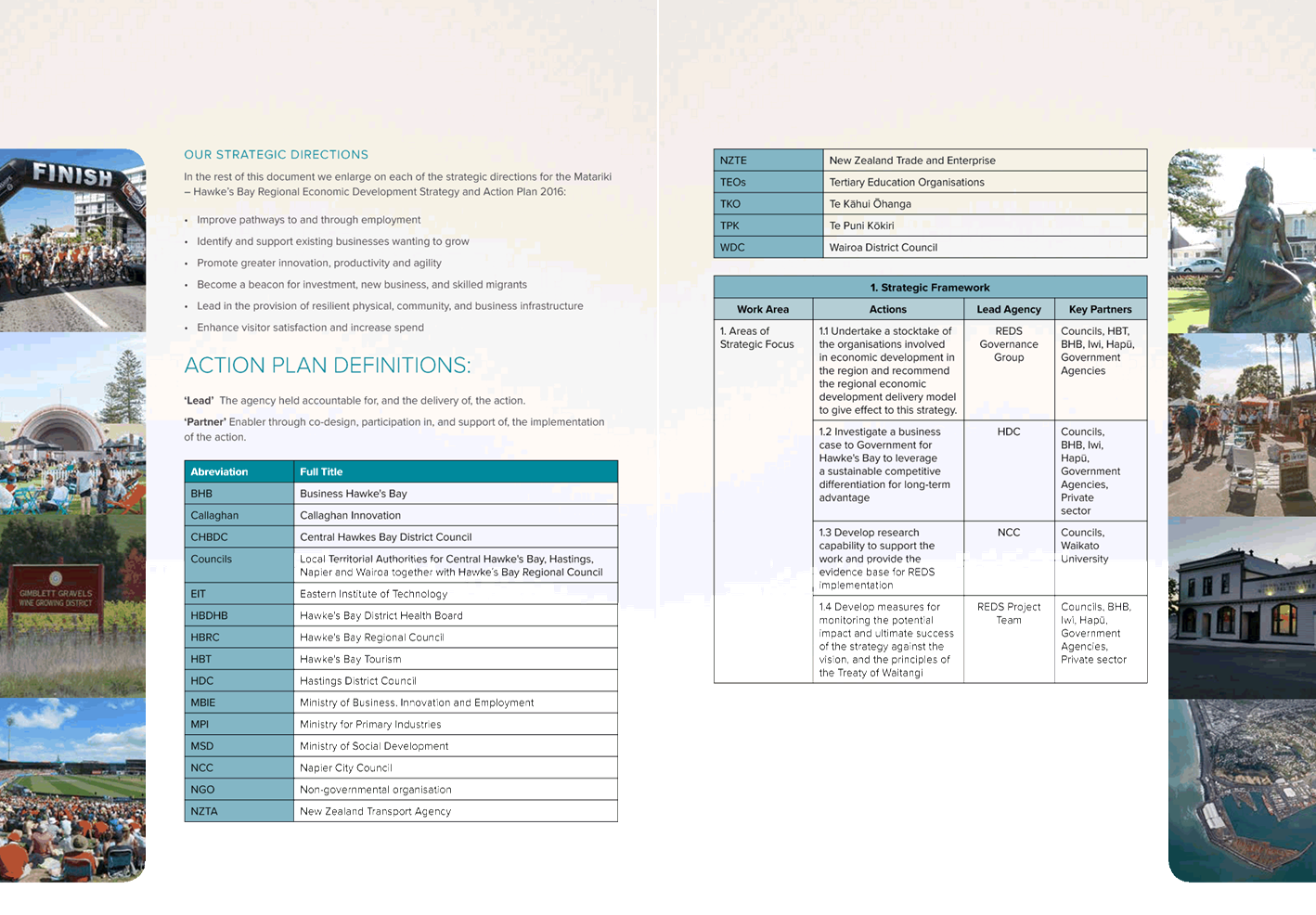
|
Regional
Economic Development Strategy and Action Plan: Matariki
|
Attachment 1
|

|
Regional
Economic Development Strategy and Action Plan: Matariki
|
Attachment 1
|

|
Regional
Economic Development Strategy and Action Plan: Matariki
|
Attachment 1
|

|
Regional
Economic Development Strategy and Action Plan: Matariki
|
Attachment 1
|

|
Regional
Economic Development Strategy and Action Plan: Matariki
|
Attachment 1
|

|
Regional
Economic Development Strategy and Action Plan: Matariki
|
Attachment 1
|

|
Regional
Economic Development Strategy and Action Plan: Matariki
|
Attachment 1
|

|
Regional
Economic Development Strategy and Action Plan: Matariki
|
Attachment 1
|

|
Regional
Economic Development Strategy and Action Plan: Matariki
|
Attachment 1
|

|
Regional
Economic Development Strategy and Action Plan: Matariki
|
Attachment 1
|

|
Regional
Economic Development Strategy and Action Plan: Matariki
|
Attachment 1
|

|
Regional
Economic Development Strategy and Action Plan: Matariki
|
Attachment 1
|

|
Regional
Economic Development Strategy and Action Plan: Matariki
|
Attachment 1
|
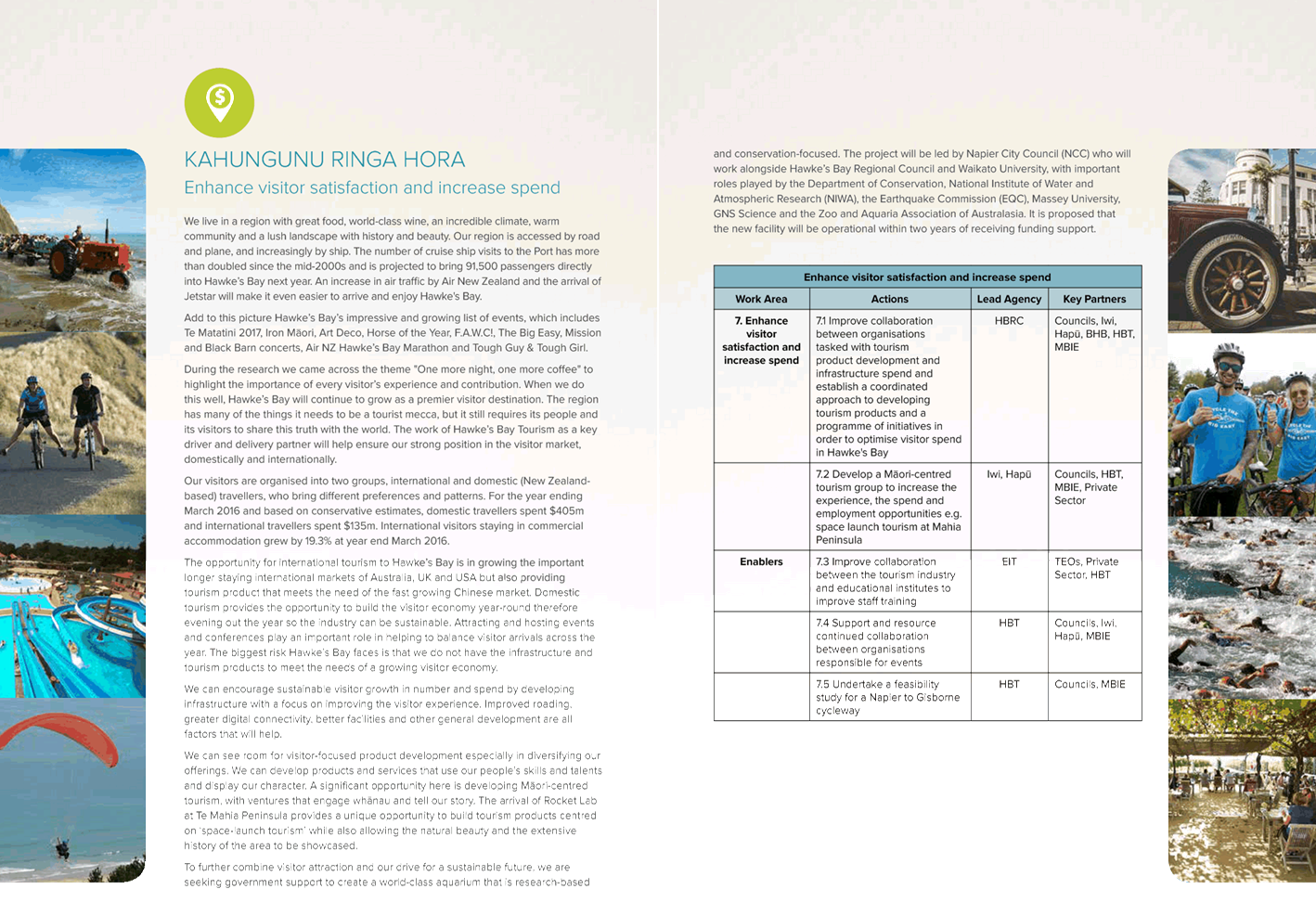
|
Regional
Economic Development Strategy and Action Plan: Matariki
|
Attachment 1
|

|
Regional
Economic Development Strategy and Action Plan: Matariki
|
Attachment 1
|
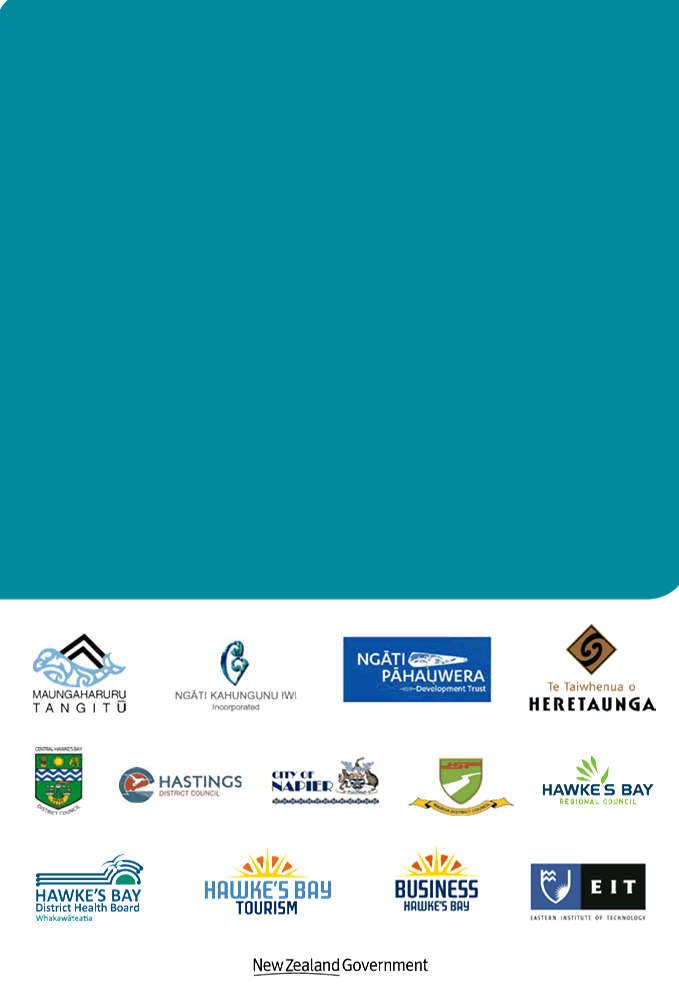
HAWKE’S BAY REGIONAL
COUNCIL
Corporate
and Strategic Committee
Wednesday 17 August 2016
Subject: Minor Items not on the
Agenda
Reason
for Report
This document has been
prepared to assist Councillors note the Minor Items Not on the Agenda to be
discussed as determined earlier in Agenda Item 6.
|
Item
|
Topic
|
Councillor
/ Staff
|
|
1.
|
|
|
|
2.
|
|
|
|
3.
|
|
|
|
4.
|
|
|
|
5.
|
|
|
HAWKE’S BAY REGIONAL COUNCIL
Corporate
and Strategic Committee
Wednesday 17 August 2016
Subject: Regional Economic
Development Strategy and Action Plan
That Council excludes the public
from this section of the meeting, being Agenda Item 16 Regional Economic
Development Strategy and Action Plan with the general subject of the item to be
considered while the public is excluded; the reasons for passing the resolution
and the specific grounds under Section 48 (1) of the Local Government Official
Information and Meetings Act 1987 for the passing of this resolution being:
|
GENERAL SUBJECT OF THE ITEM TO BE
CONSIDERED
|
REASON FOR PASSING THIS RESOLUTION
|
GROUNDS UNDER SECTION 48(1) FOR THE
PASSING OF THE RESOLUTION
|
|
Regional Economic Development Strategy and Action Plan
|
7(2)(c)(ii) That the public conduct of this agenda item
would be likely to result in the disclosure of information where the
withholding of that information is necessary to protect information which is
subject to an obligation of confidence or which any person has been or could
be compelled to provide and would be likely otherwise to damage the public
interest.
|
The Council is specified, in the First Schedule to this
Act, as a body to which the Act applies.
|
Authored by:
|
James Palmer
Group Manager
Strategic Development
|
|
Approved by:
|
Liz Lambert
Chief Executive
|
|














































































































